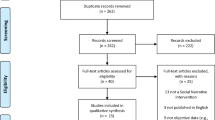Abstract
Children with autism have difficulty communicating and interacting with others. Lacking in social skills, they may exhibit symptoms of withdrawal, abnormal language patterns, and a preoccupation with unusual routines, behaviors, and objects. Therapists working with these children can create social stories to improve social functioning and behavior. Social stories are brief narratives that describe situations in terms of social cues and appropriate responses. They are individualized to the needs and abilities of the child and can be used to help children behave appropriately in social situations and to develop problem-solving skills.
Similar content being viewed by others
REFERENCES
American Psychological Association (1994). Diagnostic and statistical manual of mental disorders (DSM-IV), (4th Ed). Washington D.C.: American Psychiatric Association.
Autism Society of America (1997). What is autism? Silver Springs, MD: Author.
Bane, V., & Gorgan, D. (1995, September). In touch at last: Her love of animals and knack of inventions helped Temple Grandin escape autism's painful grip. Up Front. 42–44.
Batshaw, M., & Perret, Y. (1992). Children with disabilities: A medical primer. Baltimore, MD: Paul H. Brookes.
Bruey, C. T. (1989). Daily life with your child. In M. D. Powers (Ed.), Children with autism: A parents guide. (pp. 79–103). Rockville, MD: Woodbine House Publishers.
Freeman, J., Epston, D., & Lobovits, D. (1997). Playful approaches to serious problems: Narrative therapy with children and their families. New York: Norton.
Garand, J., & Gray, C. (1993). Social stories: Improving responses of students with autism with accurate social information. Focus On Autistic Behavior, 8. (1), 1–10.
Gardner, R. A. (1971). Therapeutic communication with children: The mutual storytelling technique. New York: Science House.
Gardner, R. A. (1993). Mutual storytelling. In C. E. Shaefer & D. M. Cangelosi (Eds.). Play therapy techniques (pp. 199–209). Northvale, NJ: Aronson.
Gray, C. (1993). Consultant to students. Jenison, MI: Jenison Public Schools.
Gray, C. (1994, October). Making sense out of the world: Stories, comic strip conversations and related instructional techniques. Autism, 1 (1), 1–10.
Gray, D. E. (1998). Autism and the family: Problems, prospects, and coping with the disorder. Spring-field, ILL: Charles C. Thomas.
Hart, C.A. (1993). A parent's guide to autism. New York: Pocket Books.
Heflin, L., & Simpson, R. (1998). Interventions for children and youth with autism: Prudent choices in a world of exaggerated claims and empty promises. Focus on Autism and Other Developmental Disabilities, 13 (4),194–211.
Hinshaw, M., & Gray, B. (1993, Fall). The role of diagnosis in the educational process. Morning News, 2–3.
Howlin, P., & Rutter, M. (1987). Treatment of autistic children. New York: John Wiley & Sons.
Klin, A., & Volkmar, F. (1995). Asperger Syndrone: Some guidelines for assessment, diagnosis, and interventions. Yale Child Study Center, 1–14.
Kuttler, S., Myles, B., & Carlson, J. (1998). The use of social stories to reduce precursors to tantrum behavior in a student with autism. Focus on autism and other developmental disabilities, 13(3), 176–182.
Mash, E., Barkley, R. (1998). Treatment of childhood disorders.(3rd Ed.). New York: Guilford.
Newsom, C., & Rincover, A. (1989). Autism. In E.J. Mash & R. A. Barkley (Eds.). Treatment of childhood disorders, (2nd Ed. pp. 286–346). New York: Guilford.
Orton, G. L. (1996). Strategies for counseling with children and their parents. Pacific Groves: Brooks/Cole.
Powers, M.D. (Ed.). (1989). Children with autism. Rockville, MD: Woodbine House.
Sattler, J. M. (1992). Assessment of children (3rd Ed.). San Diego, CA: Jerome M. Sattler.
Swaggart, B., Gagnon, E., Bock, S., Earles, T., Quinn, C., Myles, B., & Simpson, L. (1995). Using social stories to teach social and behavioral skills to children with autism. Focus On Autistic Behavior, 10. (1), 1–15.
Thomas, C. & Rudolph, L. (1996). Counseling children. Pacific Groves: Brooks/Cole.
Vollmer, L. (1995). Best practices in working with students with autism. In A. Thomas & J. Grimes (Eds.), Best practices in school psychology-III (pp.1031–1038). Bethesda, MD: National Association of School Psychology.
Wing, L. (1997, December). The autistic spectrum. Lacet, 350. 1761–1765.
Woytowich, J. M. (1994). The power of a poem in the counseling office. The School Counselor, 48, 78–80.
Yirmiya, N., Sigman, M., Kasair, C., & Munday, P. (1992). Empathy and cognition in high-functioning children with autism. Child Development, 63, 150–160.
Author information
Authors and Affiliations
Rights and permissions
About this article
Cite this article
Del Valle, P.R., McEachern, A.G. & Chambers, H.D. Using Social Stories with Autistic Children. Journal of Poetry Therapy 14, 187–197 (2001). https://doi.org/10.1023/A:1017564711160
Issue Date:
DOI: https://doi.org/10.1023/A:1017564711160




